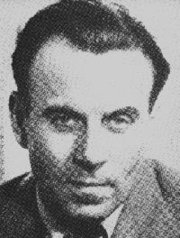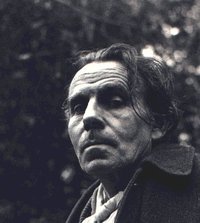|
|
Céline redirects here. Another popular Céline is Canadian singer Céline Dion.
Louis-Ferdinand Destouches as Céline (May 27, 1894 – July 1, 1961) was a French writer and physician.
| Contents |
Life
Born Louis-Ferdinand Destouches at Courbevoie in the Seine département (now Hauts-de-Seine) on May 27, 1894 into a poor family, Céline received only a basic education before he joined the French cavalry. He fought in World War I and was decorated for his actions in a battle where he was allegedly wounded in the head.
Discharged from the Army, after the war he studied to obtain a medical degree. He worked in France as a doctor, then travelled to the United States where he became the staff surgeon at the Ford Motor Company plant in Detroit, Michigan. Next he worked in Africa and for the new League of Nations before taking up a permanent position as a doctor to the poor in Paris. He then started to write in his spare time.
His best-known work is also his first: Voyage au bout de la nuit (Journey to the End of the Night) (1932, translated into English most recently and successfully by Ralph Manheim). It broke many literary conventions of the time, using the rhythms and, to a certain extent, the vocabulary of slang and vulgar speech. The book became a public success, but Céline was not awarded the Prix Goncourt, although the voting was controversial enough to become the subject of a book (Goncourt 32 by Eugène Saccomano, 1999).
In 1936 he wrote Mort à credit ("Death on the Installment Plan"), giving innovative, chaotic, and antiheroic visions of human suffering.
Openly anti-semitic before and during World War II, he was identified by the public with the Nazi occupation, despite his consistent contempt for their ideology (and all others). He escaped judgment by fleeing to Germany (Sigmaringen, 1944) along with the Vichy government and later to Denmark (1945). Branded a collaborator, he was condemned by default (1950) in France to one year of imprisonment and declared a national disgrace. Amnestied, he returned to France in 1951; unable to earn a living through medicine, and facing difficulty returning his books to print, he lived in poverty, working himself to death on his writing.
Fame came back to him in later life with a trilogy telling of his exile: D'un château l'autre, Nord and Rigodon. Céline died on July 1, 1961 of a ruptured aneurysm and was interred in a small cemetery at Bas Meudon (part of Meudon in the Hauts-de-Seine département).
Work Analysis
Céline's reputation as a writer has been overshadowed by his anti-semitism, although his importance as an innovative author has been recognized.
Pessimism pervades Céline's fiction as his characters sense failure, anxiety, nihilism, and inertia. Céline was unable to communicate with others, and during his life sank more deeply into a hate-filled world of madness and rage. However if one wishes to say this then it must be qualified by the narrative of betrayal and exploitation, both real and imagined, that punctuated his life, for his two true loves, his cat and wife, are mentioned with nothing other than kindness and warmth.
A progressive disintegration of personality appears in the stylistic incoherence of his books based on his life during the war: Guignol's Band, D'un château l'autre and Nord. However, some critics claim that the books are less incoherent than intentionally fragmented, and that they represent the final development of the style introduced with Journey to the End of the Night, his first novel, suggesting that Celine maintained his faculties in clear working order to the end of his days. He continued writing right up to his death in 1961, finishing his last novel, Rigadoon, in fact on the day before he died of a brain aneurysm.
In Conversations with Professor Y (1955) Celine defends his style, indicating that his heavy use of the ellipse and his disjointed sentences are an attempt to embody human emotion in written language.
His writings are examples of black comedy, where misfortunate and often terrible things are described humourously. Celine's writing is often hyper-real and its polemic qualities can often be startling, however his main strength lies in his ability to discredit almost everything and yet not lose a sense of enraged humanity.
Bibliography
- Voyage au bout de la nuit, 1932 (Journey to the End of the Night, 1943)
- Mort a credit, 1936 (Death on the Instalment Plan, 1938)
- Bagatelle pour un massacre, 1937
- Guignol's Band, 1944 (English translation 1954)
- Casse-pipe 1949
- Féerie pour une autre fois 1952
- Normance (Féerie II) 1954
- D'un château l'autre, 1957 (Castle to Castle, 1968)
- Nord, 1960(North, 1972)
- Guignol's band II (Le pont de Londres) 1964
- Rigodon, published posthumously in 1969
References
- [[1] (http://www.centerforbookculture.org/context/no8/knipfel.html)] by Jim Knipfel
- Critical Essays on Louis-Ferdinand Céline edited by W. K. Buckley (1988)
- Céline's Imaginative Space by J. Carson (1989)
- The Golden Age of Louis-Ferdinand Céline by N. Hewitt (1987)
- Céline: Man of Hate by Bettina Knapp (1974)
- Céline and his Vision by Erika Ostrovsky (1967)
- Louis-Ferdinand Céline by M. Thomas (1980)
- Céline: A Biography by Frederic Vitoux, trans. by Jesse Browner (1992).
- The Crippled Giant by M. Hindus (1950)
- Biographical Dictionary of the Extreme Right Since 1890 edited by Philip Rees (1991, ISBN 0130893013)
External links
- Louis-Ferdinand Céline (1894-1961) (http://www.levity.com/corduroy/celine.htm) (brief sketch)
- Louis-Ferdinand Céline (1894-1961) - pseudonym of Louis-Ferdinand Destouches (http://www.kirjasto.sci.fi/lfceline.htm) at books and writers
- Louis-Ferdinand Céline (http://www.chez.com/lfceline/) (French site with many photos)
cs:Louis-Ferdinand Céline de:Louis-Ferdinand Céline es:Louis-Ferdinand Céline eo:Louis-Ferdinand CÉLINE fr:Louis-Ferdinand Céline lb:Louis-Ferdinand Céline nl:Louis-Ferdinand Céline no:Louis-Ferdinand Celine fi:Louis-Ferdinand Céline pl:Louis-Ferdinand Céline


